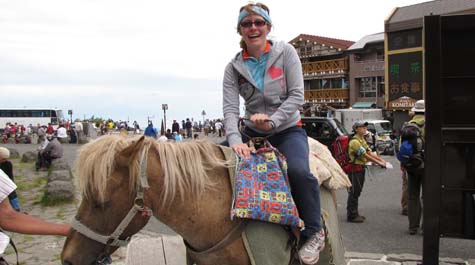VIMS graduate students pursue summer research in East Asia

For two VIMS graduate students, summer break was less about hitting the beach and more about testing new waters—literally.
VIMS Ph.D. students Katie May Laumann and Julia Moriarty were independently selected by the National Science Foundation for the prestigious East Asia and Pacific Summer Institute for U.S. Graduate Students (EAPSI). The two-month-long residency provides students in science, engineering, and education first-hand research experience working with a host scientist in Australia, China, Japan, Korea, New Zealand, Singapore, or Taiwan.
With a broad interest in how rivers transport sediments and associated nutrients to the coastal ocean, Moriarty traveled to Taiwan to work with Dr. Shuh-Ji Kao at the Academia Sinica in Taipei. Roughly 1,500 miles away, Laumann journeyed to Chiba, Japan to work on sturgeon genetics with Dr. Masaki Miya at the Chiba Institute for Science and Nature.
“Taiwan is home to some of the muddiest rivers on Earth, and their scientists have kept very good historical records of river discharge, which made me interested in going there,” says Moriarty. “Dr. Kao’s research focuses on nutrient transport in river systems, which complimented my background in coastal sediment transport.”
“Taiwan is home to some of the muddiest rivers on Earth, and their scientists have kept very good historical records of river discharge, which made me interested in going there,” says Moriarty. “Dr. Kao’s research focuses on nutrient transport in river systems, which complimented my background in coastal sediment transport.”
Moriarty completed her Master’s degree at VIMS in 2012, studying a small mountain river in New Zealand called the Waipaoa. “I’ve always been interested in physics—especially fluid dynamics, which led to my interest in the transport of sediment within coastal systems,” she says.
While in Taiwan, Moriarty analyzed how fluxes of suspended sediment and organic matter changed during river floods. "From a marine perspective, these fluxes are important for quantifying sediment, nutrient, and carbon inputs into the coastal ocean. These budgets may affect how much terrestrial carbon may be buried in ocean sediments, the availability of nutrients for ecosystems, and shoreline changes."
Intrigued by Miya’s work in mitogenomics—the study of genetic material within the mitochondria that power cellular metabolism—Laumann applied to work with him because she felt his guidance would help to make her dissertation research more compelling. Laumann's work with Miya will allow her to use full mitogenomic data—rather than segments of the mitochondrial genome—to study the evolutionary relationships among different sturgeon species.
Laumann says she "will also be using these evolutionary relationships to look at sturgeon biogeography, which is the study of sturgeon distributions through geological time, so the work I did this summer with Dr. Miya will make a great addition to my dissertation.”
Moriarty agrees, saying her summer research experience in Taiwan will help as she continues to develop her dissertation. “This summer gave me a better understanding of the processes behind sediment and nutrients in the ocean, and helped me to meet potential collaborators.”
This is not the first time Laumann and Moriarty have traveled abroad, so they knew they would be facing language barriers when arriving in their host countries. As part of the training offered through EAPSI, the pair received a crash-course in their respective languages during their first few days overseas.
“Although most of my lab spoke English, language barriers were very difficult outside of the lab in Chiba, especially when I met people who didn’t speak any English at all,” says Laumann. “I basically only knew how to introduce myself and ask how expensive something was.”
Fortunately for Laumann, technology was able to lend a helping hand. “A lot of people had translation apps on their phones, so they would hand me their phone and I would type what I was trying to say, and the phone would translate it. I had a lot of conversations that way.”
Moriarty—who completed a basic language class at William & Mary’s Confucius Institute to help prepare—ran into similar language obstacles outside the lab. She notes, however, that “Everyone I worked with spoke fair to excellent English. For me, having only two months to put a research project into place—start to finish—was just as big a challenge as the language barrier.”
Laumann and Moriarty agree that extramural research—in distant waters, with foreign colleagues, or in their cases a combination of both—provides knowledge and experiences that can be gained in no other way.
“In many different fields of science, you can manipulate one thing and study the effects, but in earth science you can’t just manipulate things like the sediment supply in a river,” says Moriarty. “Conducting research in different countries provides you with the opportunity to understand different environments.”
“I think collaborating with foreign researchers is really important,” says Laumann. "Not only just for science, but on an individual level as well, and to help our country develop and maintain good relations with other nations. I think international collaborations will help advance science.”
Sponsored by the National Science Foundation and equivalent science and technology agencies in selected foreign nations, the East Asia and Pacific Summer Institute provides international research opportunities to U.S. graduate students between June and August each year. Successful applicants propose a location, host scientist, and research project that correspond with the goals of the host site and time available for the international visit.















